Standards Worldwide
Standards Worldwide
Phone +49 30 58885700-07

Standard [CURRENT]
ASTM D 2699b:2024
Standard Test Method for Research Octane Number of Spark-Ignition Engine Fuel
- Publication date
- 2024
- Original language
- English
- Pages
- 48
- Publication date
- 2024
- Original language
- English
- Pages
- 48
- DOI
- https://dx.doi.org/10.1520/D2699-24B
Product information on this site:
Quick delivery via download or delivery service
Buy securely with a credit card or pay upon receipt of invoice
All transactions are encrypted
Short description
1.1 This laboratory test method covers the quantitative determination of the knock rating of liquid spark-ignition engine fuel in terms of Research O.N., including fuels that contain up to 25 % v/v of ethanol. However, this test method may not be applicable to fuel and fuel components that are primarily oxygenates. 2 The sample fuel is tested using a standardized single cylinder, four-stroke cycle, variable compression ratio, carbureted, CFR engine run in accordance with a defined set of operating conditions. The O.N. scale is defined by the volumetric composition of PRF blends. The sample fuel knock intensity is compared to that of one or more PRF blends. The O.N. of the PRF blend that matches the K.I. of the sample fuel establishes the Research O.N. 1.2 The O.N. scale covers the range from 0 to 120 octane number but this test method has a working range from 40 to 120 Research O.N. Typical commercial fuels produced for spark-ignition engines rate in the 88 to 101 Research O.N. range. Testing of gasoline blend stocks or other process stream materials can produce ratings at various levels throughout the Research O.N. range. 1.3 The values of operating conditions are stated in SI units and are considered standard. The values in parentheses are the historical inch-pound units. The standardized CFR engine measurements continue to be in inch-pound units only because of the extensive and expensive tooling that has been created for this equipment. 1.4 For purposes of determining conformance with all specified limits in this standard, an observed value or a calculated value shall be rounded "to the nearest unit" in the last right-hand digit used in expressing the specified limit, in accordance with the rounding method of Practice E29 . 1.5 This standard does not purport to address all of the safety concerns, if any, associated with its use. It is the responsibility of the user of this standard to establish appropriate safety, health, and environmental practices and determine the applicability of regulatory limitations prior to use. For specific warning statements, see Section 8 , 14.4.1 , 15.5.1 , 16.6.1 , Annex A1 , A2.2.3.1 , A2.2.3.3 ( 6 ) and ( 9 ), A2.3.5 , X3.3.7 , X4.2.3.1 , X4.3.4.1 , X4.3.9.3 , X4.3.11.4 , and X4.5.1.8 . 1.6 This international standard was developed in accordance with internationally recognized principles on standardization established in the Decision on Principles for the Development of International Standards, Guides and Recommendations issued by the World Trade Organization Technical Barriers to Trade (TBT) Committee.
ICS
75.160.20
DOI
https://dx.doi.org/10.1520/D2699-24B
Also available in
Loading recommended items...
Loading recommended items...
Loading recommended items...
Loading recommended items...
